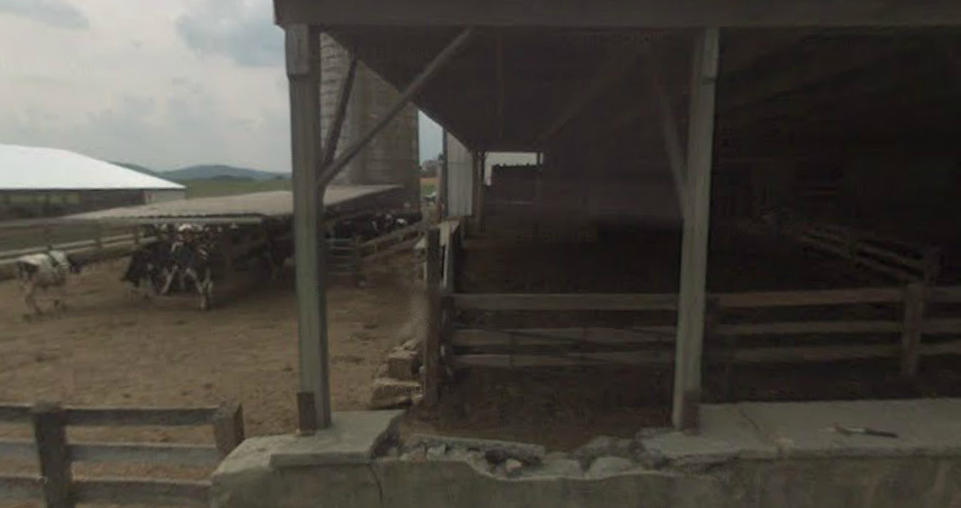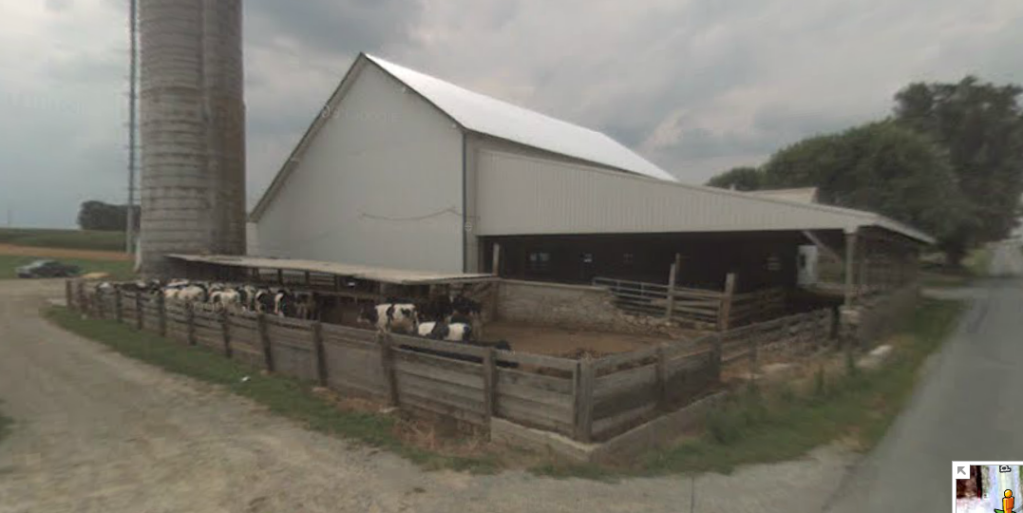I checked my mail and since you seem to be implying that I am lying here are some pics of the farm mentioned in my previous post:
This is not a big "commercial" farming operation by any definition. I can’t say for sure but I would think it reasonable to believe that, like a lot of small farmers, that the dad in this family probably holds a non-farm job, that the wife and kids help out quite a bit. This farm is not very big BTW, evidenced by the aerial view, most of the crops grown surrounding the small dairy operation, are feed corn, alfalfa and soy beans. This Google Street View is more than a few years old and the farm house renovations have been completed for quite some time. But this farm, BTW is not at all unlike many other family farms in Lancaster County PA, except that these cows are confined to a small barn and barn yard very close to the road and they have no pasture to graze in unlike a somewhat bigger family farm just up the road. And BTW, I should clarify that I did not intend to imply that this farm was doing anything wrong in how they farm or raise their cows, my point was that, knowing and seeing that farming is not a “pristine” germ free environment, even if it is “organic” and probably especially if it is “organic”, that things like pasteurization and the availability of antibiotics is for the most part a very good thing.
You’d be surprised at the number of ranchers and farmers who grow organic for themselves while raising standard for the business. This has been going on for over fifty years that I know of. When Mom decides that those cows are no longer welcome in her kitchen, it does cause an uproar. All it takes is for the fish to die in the pasture ponds after one application of the latest and greatest fertilizers being pushed in the trade magazines.
I think you are full of it. Are you saying that a large number of farmers and ranchers and their families only eat “organically” grown food and “organic” free range, etc., meats while feeding the rest of us “poisons”?
I don’t know any country folks that don’t use Heritage seeds in the family garden. Monsanto is not a welcome name in their kitchens.
Again, I think you are full of it. That’s not to say that some farmers don’t plant “heritage” seeds in their kitchen gardens’ but that’s not because they think what they are growing for sale is unhealthy. BTW a lot of people think that when they see those seed signs along the roads in front of crop fields that means it is a corporate farm – nothing is farther from the truth.
http://agricultureproud.com/2012/08/06/do-farm-signs-mislead-customers-what-else-are-we-missing/
Back in the good old days, we used root cellars and canning to save our soft vegetables and fruits throughout the winter months. The meat was killed after the deep freeze began and hung in the coolers to keep the freeze burn off of it. .. The cattle were fed corn silage and hay during the winter months. The chickens were mostly in the cooler wrapped in cotton sacks.
Once again, you prove you know not of what you speak. Root cellars were and are meant to store “root vegetables”, potatoes, turnips, onions, carrots, beets, and even cabbage, and hard fruits like apples, etc., hence the name “root cellar”. Root cellars were “cool” and with low humidity that help preserve stored foods longer but not “soft” vegetables and fruit as you claim, and they were nothing like the modern refrigeration/freezers we have now. And as far as hanging meat in the winter months in ““coolers” to keep the freezer burn off of it”, again, you have no idea what you are talking about. Unless the farmer lived in a part of the country were the winter temperature never get’s above freezing (parts of Alaska, North Dakota, etc.), and since “root cellars” do not get that cold, otherwise they’d destroy the root vegetables and “canned” stuffs stored in them, meats were salt cured and or smoked to preserve them during the long winter months.
http://www.survival-spot.com/survival-blog/build-root-cellar/
The salt was sea salt and the sugar was natural not processed.
“All “Natural” Sea salt” is a rather recent and trendy foodie product and for the most part and is mostly overpriced being that sea salt and mined salt is still sodium chloride, chemically no different, and most of the salt used by the American Pioneers was mined and did not come from the sea as the process for extracting salt from sea water is much more expensive that simply mining it.
As far as sugar, please take some time to read up on your history. Sugar cane was a very important commodity and export from the New World and sugar has been “processed” for a very long time. If you take the time to look at authentic recipes from the American and Colonial and Pioneer eras you will see that processed sugar was indeed used and that early American and pioneer general stores sold processed sugar, although it was somewhat expensive. Less processed forms of sugar like molasses were used because they were cheaper and honey was used because it was available if one kept bees or one was brave enough to raid a beehive but that was more out of necessity and the need to economize more so than any sort of idea that “processed As far as sugar, please take some time to read up on your history. Sugar cane was a very important commodity and export from the New World and sugar has been “processed” for a very long time. If you take the time to look at authentic recipes from the American and Colonial and Pioneer eras you will see that processed sugar was indeed used and that early American and pioneer general stores sold processed sugar, although it was somewhat expensive. Less processed forms of sugar like molasses were used because they were cheaper and honey was used because it was available if one kept bees or one was brave enough to raid a beehive but that was more out of necessity and the need to economize more so than any sort of idea that “processed” sugar was “bad”.



